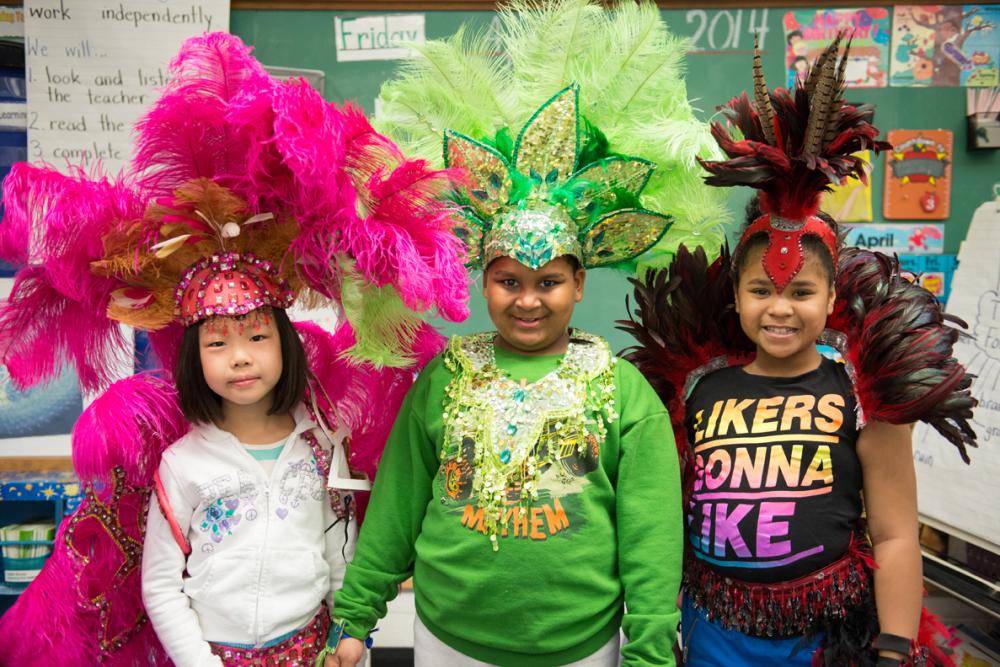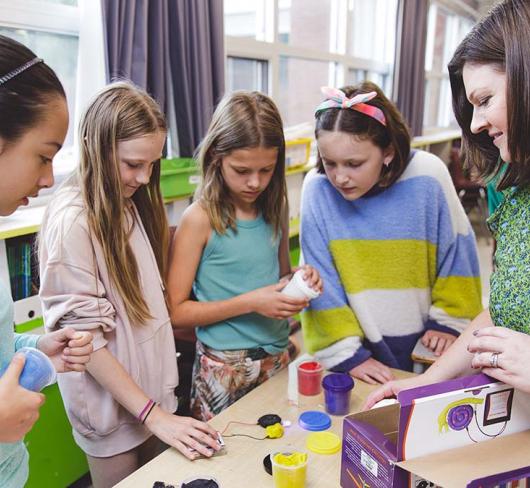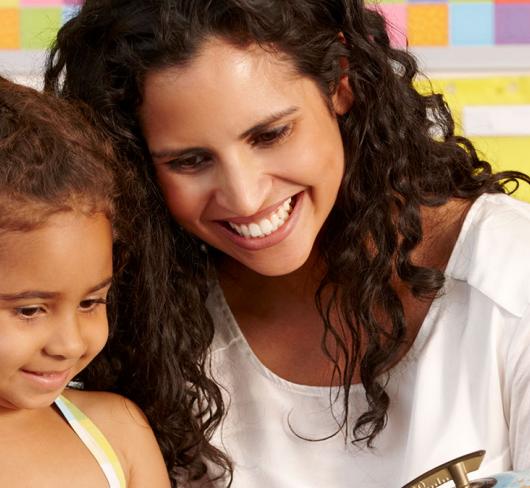
Carnival in the Classroom
On the first day of school, there is so much on my mind as I walk into my classroom with my students that I’ve forgotten about what hangs above my desk. For some, their reaction is immediate upon entry. Others take a few hours before they ask, “Whoa! What is that!? What’s it for?! Are we going to be learning about THAT this year? Did you make it? Are we going to make one? I can’t wait!” It’s the same reaction every year, whether it’s the ten-foot golden glittery snake with menacing eyes, the large white feathery tribal shields, or the vibrant pink portraits of a lost-love-inspired backpack. “Don’t worry, boys and girls. We’ll learn all about it later in the year during social studies, science, or maybe even art,” I reply. To think that what began as a sign of my “happy place” and a reminder of the summer that was and of who I am now serves to stimulate curiosity among my primary students. It’s a sign that learning in this classroom will be given a fun and meaningful context.
I was born in Trinidad and raised in Toronto. My summers provided prime exposure to the city’s Caribbean culture. As my parents visited friends and family making costumes for the annual Caribana parade in various mas (short for masquerade) camps, I’d be on the lookout for a pretty bead or feather. As they followed a music truck down University Avenue, I’d be sandwiched between my mom and dad until we met up with the moving works of art that were the finished costumes. The Civic Holiday weekend meant that the pulsating music that I only heard on tape, colourful costumes that I had only seen in pictures, and the thousands of Caribbean people that I had only seen in visits to Trinidad, would all come together to take over the streets from the business people in suits and the bustling sounds of traffic. Summer is always a change in routine for children, but my summers represented a cultural change while I learned about some Caribbean traditions.
Carnival festivities in Toronto began in 1967 when a group of immigrants from various Caribbean islands planned to celebrate Canada’s centenary by showcasing Caribbean culture as part of Canada’s cultural diversity. Each year’s events include a Children’s Parade, Calypso Monarch competitions, a steel pan competition, the King and Queen competition, and a picnic-style event. All are an experience in Caribbean culture as represented through food, drink, and the arts – music, dance, drama, and visual arts. The most prominent of these events is the Grand Parade, which is always held two days before the Monday Civic Holiday in August. However, the ideas and work begin many months, up to a year, before the actual parade. There are 10 to 16 mas bands that participate in the parade each year, in addition to at least five steel pan bands and two or three political or guest bands.
A mas band’s theme is only limited by one’s imagination. In 2011, one band used literature as a source of inspiration with their presentation of the Wizard of Oz. The sections of the band came naturally. The yellow costumes represented the “Yellow Brick Road”; the red was called “Ruby Red” in reference to Dorothy’s slippers; the pink section was named “Glenda the Good”; and the green costumes represented the “Emerald City.” In 2012, a band was inspired by candy. The sections in their “Candyland” theme included pink “Cotton Candy,” brown “Tootsie Rolls,” and rainbow-coloured “Skittles” costumes. In 2013, Louis Saldenah’s Mas-K Club band interpreted the big idea of “Heaven and Earth.” Heaven was depicted with a pink “Angel of Beauty,” light blue “Archangels,” lavender and white “Eternity,” and black and silver “Fallen Angels” costumes. Earth was represented in sections such as the orange and bronze “Autumn Spectacle,” red “Volcanic Eruption,” and blue “Tidal Wave” mas. Section leaders usually make prototypes or prepare materials in their homes until the band leader can rent a warehouse space that will serve as the band’s mas camp. Mas camps usually begin to open in late April, when the section leaders set up their work space and materials in a place where many of them will spend long days and nights hunched over a table with scissors or a glue gun. They will be making or decorating anywhere from 50 to 200 headpieces, armbands, neck pieces, leg pieces, belts, bikinis, or shorts for their section, depending on the size of the band and how many people they are expecting to register. Work is made lighter if the section leader has supportive family and friends who are able to volunteer to help with the costume making. Being a teacher has allowed me the opportunity to support the continuity of these traditions and bring some of them into my classroom. As a primary teacher, I believe that learning is facilitated when given a meaningful context. Toronto is a multi-cultural city where students are exposed to various cultural events, traditions, histories, foods, and experiences. Sharing who I am, my experiences, and my cultural history supports a safe learning environment where students feel free to share and make connections to their own cultural experiences.
It was not difficult for me to integrate learning about Carnival with curriculum expectations. In social studies, grade 1 students learn about the local community and how it meets the needs of its inhabitants. While there are the obvious physical needs of food, shelter, and clothing, there are also the emotional needs of love, safety, belonging, and recreation. The students can relate to needing an outlet to play with friends at recess, in parks, and through organized sports. I present Carnival to them as meeting a similar need for some people in the community. For grade 2 social studies we talk about the fact that Canada is a country of many cultures. The various groups bring elements of their culture to this country and contribute to the local community. I explain that culture can be identified by many features, including language, food, music, dance, clothing, crafts, stories, celebrations, and places of worship. Carnival has always been an important community celebration for many Caribbean people. However, this community is also evident on a daily basis by the roti shops in various areas of the city and the readily available jars of jerk seasoning in your average grocery. The faces on the local news, the voices and music on local radio shows, and ads for local shows, as well as concerts or events, are also evidence of the Caribbean contributions to the local community. In identifying the presence of my culture, I open the door to a discussion of the identity and participation of other cultures. When students see pictures or video of the costumes, they always ask, “How did you move that?” This question provides an entrance into the science curriculum. “Simple machines made my work easier,” I say. “Look for the simple machines that help me move such a heavy load.” My fully mounted Queen costume is usually about 20 feet high and 20 feet wide. I’ve never actually weighed one. However, you can imagine what it would be like to lift steel rods, pounds of contact cement and glue, gemstones, foil, fabric, and feathers all at once with your hands. I connect the experience to pushing a loaded shopping cart. It’s the combination of how the load is distributed and the wheels and axles that facilitate movement. For two years, the costume designer, Danzo Balroop, added a lever and pulley system. It would raise a back panel of the costume up to 20 feet in the air. In 2010, the pulley raised the wave that was to submerge Atlantis and make it an underwater city. In 2011, it was the snake that was raised into sight to tempt Eve into picking an apple in the Garden of Eden.
The connection to the arts curriculum is a natural one. However, the context of creating a Carnival costume provides a real-life example of the creative process, from inspiring, imagining, and planning stages, through experimenting and producing phases, to revising, presenting, and reflecting on your work of art. Usually in February, I bring in several parts from my previous costumes, such as headpieces, belts, neck pieces, and wristbands, to inspire them. I distribute the pieces to my students and challenge them to sort themselves into groups based on the costumes. Depending on where I am in teaching my math units, sorting and graphing can be integrated. I ask them to explain how they know which section belongs with which, a decision generally based on colour. We examine the pieces and the students share what they think the costume might represent. I share the name of the costume and relate it to the theme that the band was portraying that year. Later, I ask them to help me brainstorm ideas for our class if we want to represent a given idea, such as the forest. As a group, we create a web of ideas for what you might find in the forest, from flowers and trees, to insects and animals. Another day, we return to our brainstorming web and students choose one of the ideas that they will imagine as a headpiece that they could create to represent our forest theme. Possible materials are laid out for them to explore or experiment with how they might be used. They draw and explain the plan that they will produce. As they begin to produce their costume, they learn about making revisions due to problems they may encounter with materials or a new idea. Glue, jewels, fabric, feathers, and scissors cover every surface in the classroom. When I put on some child-friendly soca or steel pan music in the background while they work, it’s an authentic mas camp for little people.
My work as a member of the Elementary Teachers of Toronto (ETT) Arts Committee has provided the opportunity to stage a similar arts workshop for teachers on June 10, 2014 at Louis Saldenah’s mas camp. Teachers will have a similar experience of working through the creative process as outlined in the Ontario Arts Curriculum, given the reallife context of producing an item for a given theme as part of a Carnival parade. I hope to inspire teachers by providing some background and examples from the mas camp on creating costumes. We will walk through the costumes on display and discuss how each section reflects the band’s theme. They will be asked to imagine how they might represent a given theme and then draw or write a plan to create it. Teachers will experiment with some different techniques that I have used in the classroom or learned in the mas camp to create costumes. By the end of the workshop, participants will create arm pieces and a headpiece equivalent to one they could create with their students given the materials in their classroom. Opportunities to present their creations and reflect on their work of art will be given to complete the creative process.
Look out for Louis Saldenah’s 2014 presentation called “River of Mirrors” at the children’s parade on July 19 and the adult parade on August 2. The theme will showcase reflections on various periods and places as water flows through time. This group has won the title “Band of the Year” at the parade 17 times. This year’s Queen costume will be sponsored in part by ETT’s Arts Committee and it will be competing in the King and Queen show on July 31. Maybe I’ll see you over the summer at one of these events, or you can come by the mas camp to help make part of a costume. We can come up with some ideas of how to bring mas into your classroom.
Michelle Reyes is a member of the Elementary Teachers of Toronto Local.

